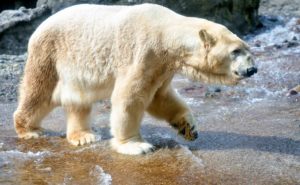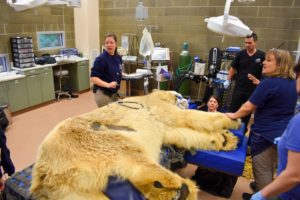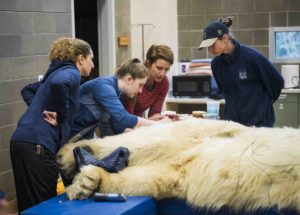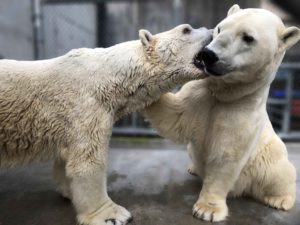
Caring for the World’s Oldest Male Polar Bear
As Boris splashed in the pool, it was as if age didn’t matter. Paw-slamming a brown ball, pushing around a blue trash can and play-wrestling with his younger buddy Blizzard, the 34-year-old polar bear swam and flipped like a youngster. Then he hauled himself out, shook out a spray of icy water, and ambled back to bed, one foot carefully, gingerly before the next.
It was a good morning for a polar bear who’s likely the oldest male in the whole world.
MEET THE BEARS: Come celebrate our bears at Chillin’ with Polar Bears Feb. 29.
“He’s so sweet,” says staff biologist Cindy Roberts. “After all he’s been through, he always bounces back.”
“He does what he wants to, when he wants to do it,” adds staff biologist Mike Messersmith.
“He’s a tough guy,” sums up staff biologist Sheriden Ploof.
Tough, because Boris has lived a long life – way over the median life expectancy of 23.4 years. As the oldest male polar bear on record in human care, where bears live longer, he’s thus assumed to be the oldest male anywhere in the world. Over half of those years have been at Point Defiance Zoo & Aquarium, where he found a safe, caring home after being rescued from a torturous life in a tropical circus.
Boris now leads a peaceful life, full of salmon treats and excellent health care. And it’s inextricably connected with the people who know him best: his keepers.
Circus Rescue

Mike Messersmith has worked at Point Defiance Zoo since 1974, and was a keeper in the Arctic Tundra area when Boris first arrived. Born in Rostock Zoo, Germany in 1985 and sold to circus life at age 4, Boris was one of seven bears rescued from the Suarez Brothers circus in Puerto Rico on November 5, 2002.
The rescue was a dramatic process that had taken many months and support from many partners, from the U.S. Department of Fish and Wildlife and AZA-accredited zoos to PETA and even celebrities. Along with Detroit, Maryland and North Carolina zoos, Point Defiance stepped up to offer two bears a home, and Boris arrived with fellow bear Kenneth on November 19, 2002 – thin, stressed and with skin conditions from his undernourished, maltreated cage life.
“He hadn’t ever had a big pool to swim in, or the choice to do whatever he wanted,” remembers Messersmith. “So when we opened up the pool here he just stood for a moment and looked at it, then looked at us, as if to say, ‘Really? I really get to do this?’ We just stepped back and told him, ‘Buddy, you can do what you like now. This is your home.’”
A New Life

Introduced to nourishing food like bear chow and fish (their circus diet had largely been bread and lettuce), Boris and Kenny gained weight and health, settling in with Glacier and Blizzard, the two male bears that already lived at Point Defiance Zoo.
“He was a very timid bear, because of everything he’d gone through,” says Messersmith, who’s still part of the keeper team caring for Boris on a daily basis. “He would react like an abused child.”
Gradually, though, Boris relaxed enough to let his unique personality come through.
“He’s always been the neutral one,” says Cindy Roberts, who was working in the aquarium when Boris arrived, but joined the Arctic Tundra team in 2009. She has since been a staunch public ambassador for polar bears, traveling to work with Polar Bears International in Churchill, Manitoba, speaking publically and organizing the annual Party for Polar Bears fundraiser, coming up this year on February 27. “We had all these males, and Kenny would dominate. But Boris could get along with anybody.”
The Oldest Bear

Polar bears at Point Defiance Zoo get the kind of phenomenal care that leads to a long life. Kenny finally died in 2012 at age 27, and Glacier in 2015. Blizzard is now 24 – younger by far, but still an impressive age for his species.
But Boris has set the world record.
“He’s a lot like your grandfather,” smiles Ploof, who has worked at the zoo for eight years. “He has good days and slow days. Sometimes he’ll be out playing in the pool for way longer than Blizzard, and other days he’ll just decide to stay in his den or nap on the sun porch.”
Boris’ team does everything possible to keep this 830-pound grandfather comfy. He gets a den full of fresh wood wool shavings daily: thick and springy and excellently scratchy on polar bear skin. He has a deep saltwater pool, and so many daily enrichments that they fill the behind-the-scenes storage areas in huge piles when not in use: barrels, trash cans, balls of all sizes, massive floating platters.

And then there’s the food – many small meals per day, with a whopping 76 vitamins and medications to keep him as healthy as his age allows. He’s had cutting-edge veterinary treatment for his age-related arthritis, and for dental and liver disease.
“Boris continues to surprise us with his resilience when facing age-related health concerns,” says Dr. Karen Wolf, the zoo’s head veterinarian. “Despite his arthritis he is still interested in playing with Blizzard and interacting with his environment. He is a great example of how zoo keepers and vets work together to help provide the best care possible for elderly zoo animals, combining TLC with advanced medical technology.”
Care and Companions

But maybe most importantly he gets regular interaction, both bear and human. He still enjoys a good mouth-wrestle with his buddy Blizzard, and greets him in the morning with a gentle mouth-touch.
And he’s surrounded by humans who care.
“We work with him on training every day, to the extent that he wants to participate,” says Ploof. “It’s enriching both physically and mentally. And we make sure to balance moving with rest.”
Many of the behaviors also help Boris with his health care: opening his mouth wide, accepting eye drops, lifting paws or walking onto a scale to be weighed. But he’ll also play the old-guy card, says Ploof wryly, pretending that he’s just too tired to do something.
Ultimately, though, Boris is the boss – albeit a gentle one.
“He tells us what he needs,” sums up Ploof, “and we do it.”
“We took Boris from a bad scenario to a place where he has a better life, and where he can be an ambassador for the Arctic,” says Messersmith. “He and Blizzard inspire people to help save his species by taking actions to slow climate change.”
“Boris never ceases to amaze me,” says Roberts. “He’s so special. Every day with him is a gift.”
MEET THE BEARS: Come celebrate our bears at Chillin’ with Polar Bears Feb. 29.
HELP WILD BEARS: Help support wild polar bears at the annual fundraiser Party for Polar Bears Feb. 27.
MEET THE KEEPERS: Meet Boris’ keepers at 11:30am daily at the Polar Bear Keeper Chat in Arctic Tundra.
LEARN MORE: Learn more about Boris’ early life and rescue in “Bärle’s Story,” a book written by the late polar bear expert and zookeeper Else Poulsen (2014, Greystone Books).